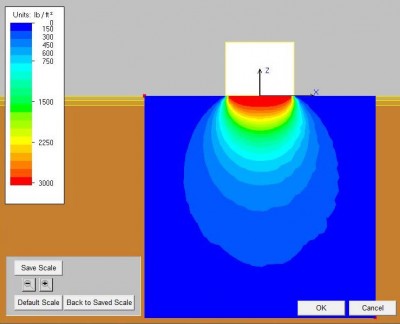Our Geotechnical Design Engineers Are The Best In The Tri-State Area
EEI’s Geotechnical Design Division will provide the most appropriate and cost-effective solution for your project from the simplest to the most highly complicated challenge. Our geotechnical design engineers have expertise in all facets of geotechnical engineering.
Temporary Shoring Design

Shallow & Deep Foundation Design
 EEI’s Geotechnical Design Division routinely develops foundation recommendations for commercial, industrial, and residential buildings to support subsurface investigations. We develop shallow foundation recommendations for spread footings and mat foundations whenever possible to provide cost-effective solutions for clients. Deep foundation recommendations are developed where bearing soils are either too weak or are susceptible to intolerable vertical deformations. EEI’s Geotechnical Design Division regularly determines axial resistance, lateral resistance, and uplift resistance of deep foundation systems including H-piles, timber piles, pipe piles, auger cast piles, mini piles, and caissons.
EEI’s Geotechnical Design Division routinely develops foundation recommendations for commercial, industrial, and residential buildings to support subsurface investigations. We develop shallow foundation recommendations for spread footings and mat foundations whenever possible to provide cost-effective solutions for clients. Deep foundation recommendations are developed where bearing soils are either too weak or are susceptible to intolerable vertical deformations. EEI’s Geotechnical Design Division regularly determines axial resistance, lateral resistance, and uplift resistance of deep foundation systems including H-piles, timber piles, pipe piles, auger cast piles, mini piles, and caissons.
EEI’s Geotechnical Design Division also has extensive experience in foundation design for transportation structures such as highway bridges and retaining walls, light standards, sign structures, dynamic message boards, and railroad bridges and retaining walls.
Soil Deformation & Hydraulic Analyses
EEI’s Geotechnical Design Division provides cost-effective alternatives to acceptable site improvements by performing detailed deformation analyses of subsurface conditions. Unacceptable vertical deformations associated with elastic settlement, consolidation, and creep can be brought within tolerable limits by partial soil exchanges, surcharging, lightweight fills, or by reducing applied loads through geosynthetic bridge lifts. We have provided numerous recommendations for expediting soil consolidation through surcharging with and without wick drains.
 EEI’s Geotechnical Design Division routinely evaluates overall stability of soil slopes. When the shear strength of subsurface soils is inadequate to support proposed slopes, we can improve stability using staged construction, geosynthetic reinforcement, or soil nails and rock anchors.
EEI’s Geotechnical Design Division routinely evaluates overall stability of soil slopes. When the shear strength of subsurface soils is inadequate to support proposed slopes, we can improve stability using staged construction, geosynthetic reinforcement, or soil nails and rock anchors.
EEI’s Geotechnical Design Division frequently conducts hydrogeology analyses for temporary and permanent dewatering for below grade structures; temporary dewatering for excavations; and dam remediation and permanent dam hydraulic performance. We can design temporary and permanent dewatering systems including well point location and depths, pump sizing, and volumetric requirements for projects of all sizes.
Some projects require development upon weak overburden soils. EEI can develop construction approaches supplemented with instrumentation design and monitoring to provide satisfactory stability and long-term performance. Improvement of weak overburden can include staged construction, lightweight fills, surcharging with and without wick drains, and other soil improvement techniques such as deep dynamic compaction and compaction grouting. EEI’s instrumentation design and monitoring includes settlement monitoring, excess pore pressure dissipation, and inclinometers.
Geosynthetic Engineering & Design
EEI’s Geotechnical Design Division is known for its geosynthetic materials expertise in civil engineering applications. With extensive knowledge in geogrid, geotextiles, geomembranes, geonets, and geocomposites, the application of these cost-effective materials are routinely featured in our designs.
Retaining Wall Design
 A regional leader in retaining wall design, EEI’s Geotechnical Design Division has extensive experience designing nearly every type of retaining wall. From residential, commercial, industrial, and transportation projects, we can develop the most appropriate, cost-effective solution for any project. Our systems include reinforced concrete cantilever, gravity segmental, mechanically stabilized earth (MSE), geosynthetic-reinforced segmental, stabilized aggregate backfilled segmental, soldier pile, and tie-back walls. EEI also commonly provides hybrids of various retaining wall systems where project constraints require maximum flexibility.
A regional leader in retaining wall design, EEI’s Geotechnical Design Division has extensive experience designing nearly every type of retaining wall. From residential, commercial, industrial, and transportation projects, we can develop the most appropriate, cost-effective solution for any project. Our systems include reinforced concrete cantilever, gravity segmental, mechanically stabilized earth (MSE), geosynthetic-reinforced segmental, stabilized aggregate backfilled segmental, soldier pile, and tie-back walls. EEI also commonly provides hybrids of various retaining wall systems where project constraints require maximum flexibility.
EEI’s Geotechnical Design Division has augmented retaining wall designs with required features to provide safe, durable structures on many projects where limited geometry is available for site development. Where retaining walls abut streams and rivers, we estimate the maximum stream velocity and scour anticipated and design for appropriate scour protection. For applications where vehicular barriers are required atop the retaining wall, EEI evaluates the vehicular design criteria and designs the vehicular barrier system necessary to provide adequate protection for traffic.
Forensic Analyses & Expert Witness Services
EEI’s geotechnical experts are frequently called upon to provide emergency recommendations, remedial designs, and forensic analyses when geotechnical engineering systems become problematic. We have extensive experience in providing technical contributions for litigation support and expert testimony.
Follow Us